Cinematic Journeys of the Self: The Alcohol Years & Stories We Tell
by: Catherine Putman , October 5, 2023
by: Catherine Putman , October 5, 2023
First-person documentary filmmakers, Chantal Akerman, Alan Berliner, Su Friedrich, Hara Kazuo, Jonas Mekas, Agnès Varda and numerous others paved the way for contemporary first-person filmmakers such as Sandrine Bonnaire, Jonathan Caouette, Yance Ford, Carol Morley and Sarah Polley, to name but a few. First-person documentary film, which is often confused with or used interchangeably with ‘autobiography,’ is a film in which the subjective filmmaker is directly implicated in the film (Lebow 2012: 2). For Alisa Lebow, first person films are ‘about a mode of address [that] ‘speak’ from the articulated point of view of the filmmaker who readily acknowledges her subjective position’ (2012: 1). What links the above first-person filmmakers is that they have all (at some point) turned to autoethnography and/or domestic ethnography for journeys of the self and others.
Autoethnography is a term that was introduced by Mary Louise Pratt to counter colonialist ethnographic texts. She states, ‘If ethnographic texts are a means by which Europeans represent to themselves their (usually subjugated) others, autoethnographic texts are those the others construct in response to or in dialogue with those metropolitan representations’ (Pratt 1992: 7). For Catherine Russell, ‘[a]utoethnography is a vehicle and a strategy for challenging imposed forms of identity’ (1999: 276). Pertaining to Russell, Michael Renov states ‘[t]he ethnographic project has long been haunted by the legacy of its colonialist past’ (1999: 140). Renov goes on to suggest that domestic ethnography is ‘another response to the ethnographic impasse’ (1999.: 141). Numerous first-person filmmakers turn to the documentation of themselves, their own family members, friends, communities, or groups and therefore avoid imposing themselves onto subjugated others.
Russell ‘sense[s]’ that ‘the [autoethnographic] filmmaker has no memory and is salvaging his or her own past through the recording of family memory’ (1999: 278). For Renov, this type of investigation is ‘a kind of identity sleuthing in which family-bound figures … are mined for clues to the artist’s vocation, sensibility, or pathology’ (1999: 142). Two films that observe Russell’s and Renov’s assertions are Carol Morley’s The Alcohol Years (2000) and Sarah Polley’s Stories We Tell (2012). Contrasting Polley’s work, Morley’s film does not include her biological family; rather, she relies on her friends’ memories to salvage her past, who for a period were, in a sense, her family. As Renov argues, domestic ethnographic films are not tied down to consanguinity. The films can engage with people ‘with whom the maker has maintained long-standing everyday relations and has thus achieved a level of casual intimacy’ (1999: 141). True, although Morley achieved more than casual intimacy with many of the participants she engages with in The Alcohol Years, which, for some, was awkward.
The autoethnographic film can be problematic because the subjective filmmakers are often implicated with their participants. Hence, Renov states that ‘consanguinity and co(i)mplication are domestic ethnography’s defining features’ (1999). The term, ‘co(i)mplication’ meaning: ‘both complexity and the interpenetration of subject/object identities’ (1999). Morley and Polley both face co(i)mpications whereby their participants are asked to talk about sensitive and taboo subjects where the filmmaker/participant is greatly implicated. Nonetheless, Moreley and Polley challenge such co(i)mplications by avoiding interjection with their family/friends’ testimonies, and by omitting their own ‘voice of god’ narration, which in turn lends the participants a ‘sharing of textual authority’ (1999: 146). Thus, I will argue that, with self-reflexivity, and interweaving archived footage, seamless re-enactments, diegetic music with the collage of talking head testimonies, Morley and Polley’s subjective authorial voices are clearly heard, even when they are not present, and are thus ambiguously subjective.
Contextualisation of The Alcohol Years & Stories We Tell
The Alcohol Years and Stories We Tell can be placed within the essay, autobiographical, self-portrait and memoir film. Frances Hatherley identifies The Alcohol Years as a ‘non-visual portrait’ (2017: 146). Similarly, Dagmar Brunow states that it is an ‘autobiographical essay film and a confession video without a confessor’ (2015: 85). Kate J. Waites suggests the term ‘documemoir’ for Stories We Tell which ‘stretches the boundaries of the memoir genre while adding a meta-twist to the documentary film’ (2015: 543). Leah Anderst also categorises Stories We Tell as an autobiographical film (2013). Both films equally adopt reflexive, participatory, performative, and poetic modes of documentary, as outlined by Bill Nichols (1983: 640). Hence, the films are nuanced and difficult to categorise, and are, as Lebow points out regarding first-person films in general: ‘poetic, political, prophetic [and] absurd’ (2012: 1). Whilst Renov points out that first-person films are ‘nothing new’ (2008: 42), Morley and Polley transcend the first-person film model and lend their own ambiguously subjective signatures; thus, The Alcohol Years and Stories We Tell resonate with audiences.
Morley and Polley both lost a parent when they were 11 years old. Morley’s father committed suicide and Polley’s mother, Diane, died of cancer. But where Polley had the support of a large family, Morley’s small family broke down and were closed about the subject. After her mother’s death, Polley became close to her father; however, a frequent family joke suggested that her father may not have been her biological father.
The Alcohol Years
As a coping mechanism after her father’s suicide, Morley turned to alcohol at the age of thirteen. Subsequently, she became a regular patron of the notorious Haçienda nightclub and music venue in Manchester, where she met the people who became her substitute family. From the age of 16 to 21, her life was a blur of excessive drinking and promiscuity. The extreme amounts of alcohol distorted Morley’s memory and she could therefore barely recollect fragments of her formative years. Morley states that perhaps she was ‘trying to die … but trying to live at the same time’ (2019). While the statement seems to contradict itself, it typifies Morley’s principles of documentary films insofar she finds documentaries problematic when contradictions are ‘ironed out’ because ‘life is contradictory’ (2019).
Whilst at dinner with fellow filmmaker Clio Barnard and Barnard’s (then) boyfriend, Adam Chodzko—who met Morley during her most promiscuous period—Morley was enlightened with stories of some of her sexual antics, none of which she could recollect. It was this meeting that triggered the idea of exploring her past behaviour; hence, 12 years after leaving Manchester for London—fitted out with her camera—Morley headed back North in search of her lost self.
In a candid interview with Fiona Morrow of The Guardian, Morley states ‘I’d fuck anybody, men or women. And of course, I had this huge reputation’ (Morrow 2000). Naturally, in Morrow’s view, heading back to Manchester to link up with many of these men and women was a brave move. Yet, Morley disavows bravery by stating that she would not have gone back without her camera: ‘it was always there, mediating for me and protecting me’ (Morrow 2000). Thus, Morley’s armour, disguised as a camera, aids her in challenging the complications and implications of this autoethnographic film.
Renov asserts that ‘[s]elf entails other; the other refracts self’ (2004: xiii); thus, in searching for herself, Morley turns to others. She places and advert in various Manchester newspapers: ‘CAROL MORLEY Film project. Please contact me if you knew me between 1982-1987.’ A close-up shot of an original advert marks the beginning of her film, the film’s self-reflexivity and Morley’s investigative process. An ensemble of old friends who were once part of Morley’s circle and in one way or another were connected to Manchester’s music scene, came forward to participate in Morley’s project. Although, in The Alcohol Years’ DVD ‘director’s commentary,’ Morley reveals that when putting the film together, one person who she asked to participate said: ‘What I have to say about you, I wouldn’t want my wife and children to hear’ (2005).
Morley asks each of her friends to be brutally honest when relaying their stories of her past. They are presented as a collage of talking heads with no textual information as to who they are, emphasising their previous community, rather than individuality. As Lebow states, ‘the individual ‘I’ does not exist alone, but always ‘with’ another, which is to say being one is never singular but always implies and indeed embodies another’ (2012: 2-3). Whilst Morley later recognises each participant in the closing credits who are placed in order of appearance under the heading ‘The Alcohol Years were spent with,’ the double entendre of the phrase underscores the embodiment of ‘another.’
The participants talk straight to Morley (and therefore us) who is positioned behind the camera, gazing back at them. Apart from the sound of a giggle after Alan Wise asks Morley when she wants to film his penis, we never hear Morley’s voice. However, we do get a glimpse of Morley on a few occasions, including the visceral, slow motion, extreme close-up shot of her notoriously extra-large tongue (figure 1). This shot is interweaved with the voiceover of Dave Haslam’s, albeit reluctant, testimony: ‘everyone liked the size of your tongue.’ Rather than verbally react to Haslam’s comment, Morley remains the absent figure, instead she frames her own fragmented tongue on her terms. This disjointed image of course adheres to Laura Mulvey’s assertions that ‘[o]ne part of a fragmented body destroys the Renaissance space’ and thus subverts ‘verisimilitude to the screen’ (1989: 20). Thus, Morley maintains her ambiguously subjective position.
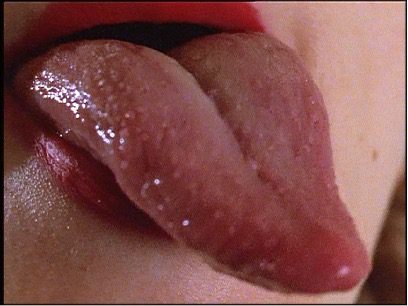
The first instance we see Morley is 35 seconds into the film—in reflexive mode (figure 2). She is framed in a medium close-up shot, showing off her mischievous grin, poised with her camera. This is layered with Franke Lane’s voiceover: ‘I think everybody hated you Carol; to a certain degree … you were very manipulative.’ Lane’s statement thus renders the image oxymoronic insofar it is playful, and Morley does not appear to be manipulative; however, it pertains to Clio Barnard’s notion, that filmmakers can be manipulative, and states, ‘whenever we watch a film we’re being manipulated, and we’re encouraged to forget that’ (2011). So rather than verbally agreeing with Lane, Morley inserts the image over the top of Lane’s dialogue to suggest that she was manipulative during her ‘alcohol years’ and ambiguously suggests that—as a filmmaker—perhaps she still is.

There are many film references within The Alcohol Years, which have subsequently become a Morley trope. Peppered throughout the film, seamless re-enactments represent a young Morley in a red coat walking down cobbled alleyways and busy streets. Notably, one sequence presents her scurrying under a canal bridge, which is a reference to Nicolas Roeg’s Don’t Look Now (1973), suggesting Morley’s spectral presence (figure 3). Another re-enactment frames and older portrayal of Morley in a high angled shot, whilst she is in bed. As she turns her head, she smears red lipstick on a crisp white pillow. This is a reference to the disturbed main protagonist, Carole Ledoux (Catherine Deneuve), in Roman Polanski’s Repulsion (1965). In the latter film’s conclusion, the camera pans to an old family photograph where a young Carole is looking away from the camera’s gaze, suggesting she is looking at the ghost who haunts and rapes her in her adult life. Morley evokes Carole’s ghostly presence which suggests that she has been haunted since the age of 11 by her father’s suicide. Early in the film, Liz Naylor—who explicitly condemns Morley—tells her: ‘nothing was real about you, and you were just in this kind of film of your life.’ Whether Naylor’s comments inspired Morley to entangle her life with film characters’ stories for these specific re-enactments is unknown. Regardless, by using Naylor’s statement in her film, Morley awards her friend a subtle form of what Renov calls, a ‘shared textual authority’ (1999: 146).
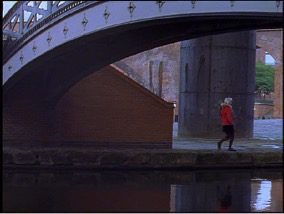
Music is of great importance in The Alcohol Years; as mentioned earlier, it connects all the participants and Morley in one way or another, and the film’s soundtrack emphasises this. Stella Grundy’s (who also takes part in the film) music is most prominent, the lyrics capturing Morley’s past in ‘The Girl Who Can’t Say No:’ ‘Red eyes, red witch, you drink too much … Just a girl who can’t say no.’ This song is layered over many sequences; significantly in response to Kym Pople’s question: ‘How many men did you sleep with?’ Again, showing her subjective position as a filmmaker and female subjectivity, a straight cut then presents a montage of lit windows shot at night which substitute Morley’s literal voice, culminating in a shot of a tower block’s metaphorical countless windows.
Stories of Morley’s extreme sexual appetite become more explicit as the film progresses. Deployed as a voice-over, Gary White relays a story about Morley having sex on her cooker with a gas man. Subscribing to the tenets of neo-realism, Morley employs a local gas man for the re-enactment scene. However, in the ‘director’s commentary,’ Morley states that she cannot recollect this story—she does however remember having sex with her postman (2005). Yet again, Morley does not interject, and although she does not recollect the story, she still presents a re-enactment that pertains to White’s version. Writing about the re-enactments in his film, The Thin Blue Line (Errol Morris, 1988) —which presents 5 different re-enactments to represent 5 contradictory accounts of a crime—Errol Morris points out that ‘[m]emory is an elastic affair’(2008). Thus, Morley respects White’s memories; however, by giving the sequence a satirical stance, where the gas man is posing for the camera, evoking a low-budget pornographic film, Morley is illustrating her omnipresence and subjective female gaze.
There are two participants who are explicitly judgemental about the making of her film: Tony Emsley and Gary White, who are both seemingly angry with Morley and question her intentions in making The Alcohol Years. Emsley asks, ‘what are you trying to prove here?’ But significantly, White asks: ‘don’t you find the outside world interesting enough? Don’t you find other people interesting enough? Why don’t you make a film about them?’ Again, Morley does not interject, but states in her ‘director’s commentary:’ ‘in thinking that they were talking about someone else, i.e., me, the people in the film actually reveal a lot about their attitudes and ideas’ (2005).
Furthermore, the question White asks is an interesting one in terms of Russell’s and Renov’s anti-colonialism theories of autoethnography and domestic ethnography, whereby as Russell argues, ‘[t]he oxymoronic label “autoethnography” announces a total breakdown of the colonialist precepts of ethnography’ (1999: 277). In a sense then, to borrow Leah Anderst’s term to describe Stories We Tell, Morley ‘does theory’ of autoethnography and domestic ethnography (2013).
Stories We Tell
Sarah Polley’s Stories We Tell is an interrogation of a family who at first blush seem quite unremarkable. However, as the film proceeds, historical secrets and lies are unearthed. Before making the film, Polley discovered that her father, Michael Polley, was not her biological father. As a child, Polley did not look like Michael, and it had been a long-standing family joke that perhaps he was not her father. This was further fuelled by John, one of Polley’s older brothers, who said he overheard their late mother, Diane, talking on the telephone, telling someone that she did not know who the father of her unborn child was. Diane died of cancer when Polley was (akin to Morley) 11 years old; for fear of upsetting her father, Polley did not glean any official information from him instead making her own inquiries. Geoff Bowes was the person most people thought likeliest to be Polley’s biological father, but he denied even having had sex with Diane. However, during a meeting with Canadian film producer, Harry Gulkin—to discuss Geoff Bowes—Harry confessed that he was Polley’s father, and a subsequent DNA test confirmed his declaration.
When Polley told Michael about her discovery, he reacted by stating that she had a great story, and elected to write his own autobiographical account. Written in the third person, it was subsequently narrated by Michael himself for Stories We Tell. This is interweaved with Michael’s ‘talking head’ testimony, which is told in the first-person, alongside the testimonies of her biological father, Harry, Polley’s siblings, wider family, and Diane’s friends. For the testimony filming, Polley asks everyone (who are all aware of the outcome) to tell the whole story from beginning to end as if she did not know the story. As Anderst points out, Polley’s focus in the making of her film, is not the plot; instead, she is more interested ‘in the story’s telling and in the ways that truths, people, and selves can be told and represented’ (Anderst 2013). The film is essentially a journey of the self; however, because Diane is a missing key figure, it consequently also becomes a film about her. As Lebow asserts ‘many times we find that first person filmmaking goes further, well beyond the self, focusing its sights on another as the ‘protagonist,’ the main attraction, and the ‘subject’ of the film’ (2012: 3).
Like Morley, Polley omits her own perceptions of some of the stories that are being told and does not interject with the participants in the ‘talking head’ sequences (although we occasionally hear her ask some of the initial questions, and later in the film, we hear her narrate some of her own emails). In an interview with Anne Thompson, Polley states that in the film’s first incarnation she would tell her version of the story, but soon realised:
my version doesn’t have a place here … And if I introduce some kind of voice-over, it all of a sudden becomes the ‘voice of God’; and all these other people are just kind of being set up just to be knocked down. So, in fact my job is to be the filmmaker and the detective in this story and my version is omitted (Polley 2013).
She goes on to say that it took a lot to surrender, because some of the testimonies were not how she remembered them. Instead, she interweaves archived films and seamless re-enactments to show her voice and thus, in common with Morley, challenges Renov’s notion of co(i)mplications.
From the outset, Polley’s self-reflexivity is evident. As Michael is preparing to record his third-person narration, we see a figure with a Super 8 camera filming the actual camera person who is filming Michael. Furthermore, a montage of shots reveals Polley’s siblings as they are nervously preparing for their testimonies. Mike booms, lights and technical paraphernalia share the frame whilst they anxiously breathe in, straighten their clothes and interact with Polley. Again, all this is going on while another camera person captures the preparations with a Super 8 camera.
Throughout the film, we are presented with a myriad of images of Diane through the media of photographs, Super 8 footage, and re-enactments (with Diane played by Rebecca Jenkins). However, what is notable about the collage of talking head preparation sequences is that Polley interweaves an archived black and white film of Diane at a television audition, as she sits nervously alongside her children in front of a camera, waiting to perform. Polley also includes herself in the collage by inserting a Super 8, out of focus, medium close-up of her face as she is also waiting to proceed with the interviews. Adding another layer, the non-diegetic song, ‘Skinny Love’ by Bon Iver, bridges the spatio-temporal jumps. A graphic match of Diane’s audition footage replaces Polley’s framed head, emphasising their physical resemblance and consanguinity (figure 4). Thus, the audition footage positions Diane alongside her family, who face the emotional and co(i)mplications of talking about their deceased mother. Furthermore, Diane, who has seemingly missed her cue to perform, talks straight to the camera, and therefore us, and asks: ‘Me? D’ya want me? Oh, I’m sorry.’ This subtle gesture could be read as Diane offering Polley her blessing to make her film and bare all. Thus, Polley challenges co(i)mplications.
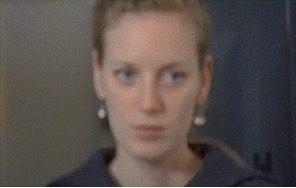
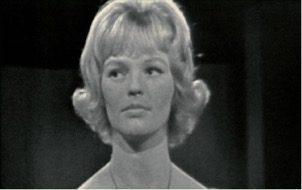 Fig. 4: Graphic match of mother & daughter, Stories We Tell (2012).
Fig. 4: Graphic match of mother & daughter, Stories We Tell (2012).
Early in the film, Michael utters to Polley: ‘I hope you’ll explain to me sometime what it is you are trying to do … two [sic] cameras…you are recording it visually.’ Polley then questions his question, to which Michael states, ‘Well, it’s not the normal way of doing it, is it?’ Subsequently, whilst off camera, Polley ask her sister, Joanna, ‘What do you think of this documentary being made?’ After an initial pause and Polley’s additional comment that Joanna can be honest, she responds: ‘who fucking cares about our family? Right. Can I swear? Like, who cares about our stupid family. I’m so embarrassed.’ Although Joanna is laughing whilst she speaks, she, like Michael, acts as a critique of the film. By including these scenes in the film, Polley is laying bare what her intentions are. As Anderst points out, the plot is almost irrelevant; what supersedes it is Polley’s position ‘as a theorist of autobiographical narrative’ (2013). And, for Anderst, Polley ‘does theory’ (Anderst 2013).
Polley implicitly demonstrates a subtle version of Renov’s notion of domestic ethnographies’ sharing of textual authority. One example occurs at the point when the family are all making their suggestion as to who Polley’s biological father might be. Michael’s third person narration layered over the top of archive footage of Polley as a young girl, and re-enacted sequences of the whole family around a dinner table, present Polley (with her red hair) looking quite different from her siblings. Then, the collage of talking heads all mention, one after the other, the name—Geoff Bowes. John is the last in the montage to say the now-famous name. Thereafter, trying to control his laughter, he states, whilst gesturing with his hands: ‘That’s what this film is going to be like—Geoff Bowes! Geoff Bowes!’ (figure 5). Thus, in post-production Polley edits the film according to John’s suggestion.
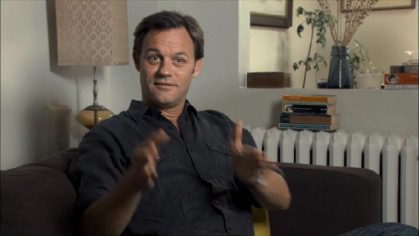
Adding another textual layer of storytelling, Polley deploys re-enactments employing the very people who she wants to depict. This is not unique to re-enactments in documentary: Abbas Kiarostami’s neo-realist Close-Up (1990) and Joshua Oppenheimer’s phantasmagorical The Act of Killing (2013) are but two good (and disparate) examples of how this mode of re-enactments can be effective in documentary films. However, Polley’s rendering of this form of re-enactment is unique insofar she captures them with a Super 8 camera and adds the participants’ dialogue over the top. For example, Harry and Polley are filmed in a coffee shop recreating the moment where they meet to discuss her mother’s affair with Jeff Bowes. When Polley mouths: ‘Do you think it was Geoff Bowes?’ (figure 6) It is in fact Harry’s voice that we hear, because this is his version of the story. By choosing to film this re-enactment sequence with the Super 8 camera, which has no sound recording device, Polley is again removing her voice from the film; thus, she does not position herself as ‘the voice of God,’ but by re-enacting her own scenario she is demonstrating her subjective position.
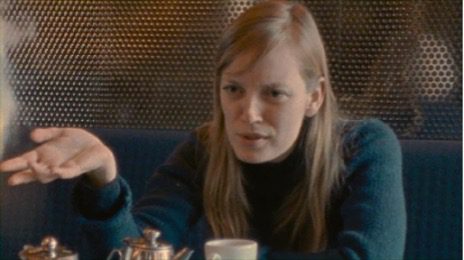
A third critique of the film comes from Harry, who thinks that the story, whether in the form of a written memoir or a film, should come from his point of view and states: ‘The reality is, essentially, the story with Diane, I regret to say is only mine to tell. And I think that’s a fact.’ However, Polley awards the story to Harry, Michael and all her siblings; moreover, she gives them all a subtle sharing of textual authority, and the film’s ‘afterword’ is a good example of this. In the latter part of the film, Michael is asked a series of sensitive questions by Polley, about the days before Diane’s death. Clearly emotional and holding back the tears, Michael turns the mood around and quips: ‘This is a dire line of questioning … We must find a way of making it more fun.’ And whilst laughing to himself, he asks Polley: ‘What are you? Some kind of sadistic interviewer or something?’ Again, Polley omits her actual voice, but marks her response to Michael’s suggestion in the film’s afterword. At the film’s conclusion the screen fades to black, with melodramatic, vaudeville ‘revealing’ piano music layered over the top. Next, we see the now legendary Geoff Bowes as he is being interviewed. Polley asks him that even though a DNA test proved that Harry was her father, how did he feel that so many people thought he was her father. Looking somewhat uncomfortable, he replies: ‘Umm, well, OK then, I’ll have to tell you that [Diane and I] did sleep together.’ Thus, adhering to Michael’s suggestion, Polley concludes the film with humour and ambiguity. A film review by Emma Hill in The Lancet states, ‘Our reliability as witnesses, recollecting times past, is questioned right to the very end, when we are left wondering if Polley herself can indeed be trusted to tell her tale’ (2013: 1053).
Conclusion
Due to blood ties and close friendships, Morley and Polley faced Renov’s notion of co(i)mplications whereby Morley’s friends were asked to be brutally honest in their accounts of Morley’s promiscuity, which put their own reputations at risk. Equally, Polley asked her family to talk about sensitive family issues and secrets. And, of course, Geoff Bowes also risked his own reputation by answering questions about his relationship with Diane. However, by omitting their own spoken testimony, even when it does not agree with numerous accounts, Morley and Polley both challenge Renov’s notion. They achieve this by interweaving filmic devices such archived film footage, seamless re-enactments, music, and film references alongside the collage of talking heads and voiceovers, thus giving their films their own ambiguous subjectivity, which in turn bestows subjectivity on all the participants.
Dagmar Brunow suggests that The Alcohol Years is a ‘first person film without the “I”’ and although it is a confessional film, the confession ‘is not exerted by [Morley]’ (2015: 85). I suggest otherwise: film form, choices of documentary modes and cinematic spectral references are Morley’s authorial voice. As Morley points out in the ‘director’s commentary,’ ‘my absence from the film was an idea I had from the start, I wanted to create a ghostly presence, to have somebody talked about who only existed in memory.’ (2005). Thus, we never hear Morley while she films her participants, though she is present throughout the film and exemplifies Lebow’s definition of first-person documentary films, that they ‘can … be understood to be a ‘cinema of we’’ (2012: 3).
In the director’s commentary, Morley explains that although The Alcohol Years is about a group of people in 1980s Manchester, ‘lots of people [from all over the world] have found it connected to their own time and their own place’ (2005). Similarly, Polley asserts that she ‘wanted people to have the ability to come to [her] film and bring their own family history’ (2012). Thus, Morley and Polley’s autoethnographic approach, which counters the colonialist precepts of ethnography, work in remarkable ways. By avoiding the imposition of themselves onto subjugated Others and instead turning to the self, The Alcohol Years and Stories We Tell connect with universal audiences.
REFERENCES
Anderst, Leah (2013), ‘Memory’s Chorus: Stories We Tell and Sarah Polley’s Theory of Autobiography,’ Senses of Cinema, December 2013, Memory’s Chorus: Stories We Tell and Sarah Polley’s Theory of Autobiography – Senses of Cinema (last accessed 5 July 2021).
Barnard, Clio (2009), ‘Clio Barnard: The Arbor’ Filmmaker, 27 April 2011, Clio Barnard: The Arbor | Filmmaker Magazine (last accessed 5 July 2021).
Brunow, Dagmar (2015), Remediating Transcultural Memory: Documentary Filmmaking as Archival Intervention, Berlin & Boston: De Gruyter Inc.
Hatherley, Frances (2017), ‘Sublime Dissension: A Working-Class Anti Pygmalion Aesthetics of the Female Grotesque,’ PhD thesis, Middlesex University.
Hill, Emma (2013), ‘Film Review: Stories We Tell,’ The Lancet, Vol. 14, October, p. 1053.
King, Homay (2013), ‘Born Free? Repetition and Fantasy in The Act of Killing’ Film Quarterly, Vol. 67, No. 2, pp. 30-36.
Lebow, Alisa (ed.) (2012), The Cinema of Me: The Self and Subjectivity on First Person Documentary, New York & Chichester: Columbia University Press.
Morley, Carol (2005), ‘Director’s Commentary for The Alcohol Years, The Alcohol Years, Directed by Carol Morley [DVD] (UK: Cannon and Morley Productions).
Morley, Carol (2019) ‘Film director Carol Morley speaks to Miranda Sawyer,’ Sound and Vision, 17 Feburary 2019, Sound and Vision – Carol Morley – BBC Sounds (last accessed 7 July 2021)
Morris, Errol (2008), ‘Play it Again, Sam (Re-enactments, Part One)’ The New York Times, 3 April 2008, https://opinionator.blogs.nytimes.com/2008/04/03/play-it-again-sam-re-enactments-part-one/ (last accessed 5 July 2021).
Morrow, Fiona (2000), ‘Going Back to the Bottle’ The Guardian, 5 June 2000, Going back to the bottle | Gender | The Guardian (last accessed 5 July 2021).
Mulvey, Laura (1989), Visual and Other Pleasures, Basingstoke & New York: Pelgrave.
Nichols, Bill (1983), ‘The Voice of Documentary’ in Jonathan Kahana (ed.), The Documentary Film Reader, (2016), Oxford: Oxford University Press, pp. 639-651.
Polley, Sarah (2012), ‘Stories We Tell director Sarah Polley in Studio Q,’ interview with Jian Ghomeshi, 3 December 2012, “Stories We Tell” director Sarah Polley in Studio Q – YouTube (last accessed 5 July 2021).
Polley, Sarah (2013), ‘Sarah Polley talks ‘Stories We Tell,’ interview with Anne Thompson, 6 May 2013, Sarah Polley Talks ‘Stories We Tell’ – YouTube (last accessed 5 July 2021).
Pratt, May Louise (1992), Imperial Eyes: Travel Writing and Transculturation, London: Routledge.
Renov, Michael (1999), ‘Domestic Ethnography and the Construction of the ‘Other’ Self’ in Jane Gaines and Michael Renov (eds.), Collecting Visible Evidence, Minneapolis & London: University of Minnesota Press, pp. 140-155.
Renov, Michael (2004), The Subject of Documentary, Minneapolis & London: University of Minnesota Press.
Renov, Michael (2008) ‘First-Person Films: Some theses on self-inscription’ in Thomas Austin &Wilma de Jong (eds.), Rethinking Documentary: New Perspectives, New Practices, Maidenhead: McGraw Hill/Open University Press, pp. 39-50.
Russell, Catherine (1999), Experimental Ethnography: The Work of Film in The Age of Video, Durham & London: Duke University Press.
Waites, Kate J. (2015), ‘Sarah Polley’s Documemoir Stories We Tell: The Refracted Subject,’ Biography, Vol. 38, No. 4, pp. 543-555.
Films:
The Act of Killing (2013), dir. Joshua Oppenheimer.
The Alcohol Years (2000), dir. Carol Morley.
Close-Up (1990), dir. Abbas Kiarostami.
Don’t Look Now (1973), dir. Nicolas Roeg.
Repulsion (1965), dir. Roman Polanski.
Stories We Tell (2012), dir. Sarah Polley.
The Thin Blue Line (1988), dir. Errol Morris.
WHO SUPPORTS US
The team of MAI supporters and contributors is always expanding. We’re honoured to have a specialist collective of editors, whose enthusiasm & talent gave birth to MAI.
However, to turn our MAI dream into reality, we also relied on assistance from high-quality experts in web design, development and photography. Here we’d like to acknowledge their hard work and commitment to the feminist cause. Our feminist ‘thank you’ goes to:
Dots+Circles – a digital agency determined to make a difference, who’ve designed and built our MAI website. Their continuous support became a digital catalyst to our idealistic project.
Guy Martin – an award-winning and widely published British photographer who’s kindly agreed to share his images with our readers
Chandler Jernigan – a talented young American photographer whose portraits hugely enriched the visuals of MAI website
Matt Gillespie – a gifted professional British photographer who with no hesitation gave us permission to use some of his work
Julia Carbonell – an emerging Spanish photographer whose sharp outlook at contemporary women grasped our feminist attention
Ana Pedreira – a self-taught Portuguese photographer whose imagery from women protests beams with feminist aura
And other photographers whose images have been reproduced here: Cezanne Ali, Les Anderson, Mike Wilson, Annie Spratt, Cristian Newman, Peter Hershey
